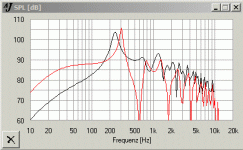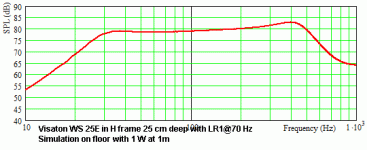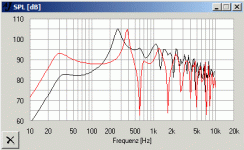Re: Re: Re: verticle stacked ripoles
I think I have found it. Topic title was "Neighbor friendly dipole sub".
Telstar said:
Because audiocircle database failed just a few days ago, the link does not work anymore. Which was the forum and topic title?
I think I have found it. Topic title was "Neighbor friendly dipole sub".
But it says "Only registered members are allowed to access this section."
The other one used to have open access.
The other one used to have open access.
Iliya said:But it says "Only registered members are allowed to access this section."
The other one used to have open access.
Dunno. I'm registered there anyway.
Is this Dayton a suitable driver?
Hello folks,
I am looking for ripole drivers to complete my sensitive B&G Neo 10 + Neo 3 mid and high units.
I need to cross at 300 HZ, so the ripole should be usable to this frequency.
I like this driver Dayton sd270-88 because it is sensitive (92,7 db), apparently fits the parameters and it is not expensive.
I would like to build 10" units to keep cabinet sizes acceptable
Hope to get some feedback and/or suggestions for other (reasonably priced) 😱 sensitive drivers.
Thanks, Peter
Hello folks,
I am looking for ripole drivers to complete my sensitive B&G Neo 10 + Neo 3 mid and high units.
I need to cross at 300 HZ, so the ripole should be usable to this frequency.
I like this driver Dayton sd270-88 because it is sensitive (92,7 db), apparently fits the parameters and it is not expensive.
I would like to build 10" units to keep cabinet sizes acceptable
Hope to get some feedback and/or suggestions for other (reasonably priced) 😱 sensitive drivers.
Thanks, Peter
I need to cross at 300 HZ, so the ripole should be usable to this frequency.
I like this driver Dayton sd270-88 because it is sensitive (92,7 db), apparently fits the parameters and it is not expensive.
I would like to build 10" units to keep cabinet sizes acceptable
Hello Peter,
I did a simulation for one Dayton in a Ripole, using the data of Udo Wohlgemut.
Red is the simulation for the frontloaded horn (3 cm wide). The resonance peek is at 300 Hz. You can`t push it any higher with the Dayton. It mainly depends on the ripole size - which is given by the driver size. You need to be lucky to find a driver that can push the resonance much higher.
Black is the simulation for the backloaded horn (10 cm wide). It shows the dipole roll-off for the ripole. If you want to EQ for 40 Hz as the lower limit, sensitivity would be down to 75 dB for 2,83 V and 1 m. This is already including the floor backup.
Attachments
Hello Rudolf
I have 4 audax Pr300T0 : http://www.hautparleur.fr/_audax/pr300t0.jpg
Would you please let me know if I could build a Ripol box with 2 speakers, and obtain good results (60-150hz )?
Thanks !
Richard
I have 4 audax Pr300T0 : http://www.hautparleur.fr/_audax/pr300t0.jpg
Would you please let me know if I could build a Ripol box with 2 speakers, and obtain good results (60-150hz )?
Thanks !
Richard
Last edited:
Hmm,
The search will continue then.🙁
Come on,
ripoles are not first choice for efficiency IMHO, and you are looking for wrong driver parameters.
How about this cheap (30 Euro) Visaton WS25E in a H frame? Take two of them and you are almost there. You are heading for 88 dB with the Neo 10, right?
H frame would be 29 cm wide though.
Attachments
Hello Rudolf
I have 4 audax Pr300T0 : http://www.hautparleur.fr/_audax/pr300t0.jpg
Would you please let me know if I could build a Ripol box with 2 speakers, and obtain good results (60-150hz )?
Thanks !
Richard
Hello Richard,
just as an illustration for all interested parties, and I am NOT starting to do these sims on an hourly basis 🙄😛.
This looks like a much better ripole driver. Front opening is 5 cm wide. Back opening is 10 cm wide, but could be wider without hurting much. Both chambers are 30 cm deep and 30 cm high inside.
This sim is for one driver only - AJ horn does not more. Just add another one for your efficiency calculations and make the common front opening 10 cm wide.
Notice how the output at the front is increasing from 150 to 30 Hz by 5 dB. This increase will be "eaten up" by the dipole loss. This loss is documented in the black line. At 33 Hz it is only about 6 dB below its value at 150 Hz. So you will only need a few dB EQ.
Resonances are well above 150 Hz too.
Rudolf
Attachments
Hello Rudolf !
Thanks for this simulation, now I have a more precise idea what to do with. May be this would help somebody else, the Audax Pr300T0 bought from Ebay Belgium last year...
Greatfull Thanks!
Richard
Thanks for this simulation, now I have a more precise idea what to do with. May be this would help somebody else, the Audax Pr300T0 bought from Ebay Belgium last year...
Greatfull Thanks!
Richard
Hi all.
I've started my Ripole subs project using (4) Peerless SLS 12's and boxes will consist of 19mm MDF + 5mm oak plywood glued on. At this time I have the panels cut to initial oversize and the plywood glued on. Now I need a sanity check and some advice on the best choice between the (3) versions I'm considering. I'm not well versed on ripole design but I'm using Rudolf's generic guidelines for reference.
View my sketches here:
Jazzman's DIY Electrostatic Loudspeaker Page: Ripole subs are underway
I rather like the looks of the ultra-compact design of version 2, which has the woofer magnet ring flush to the box sides. However, the rear chamber is less than 1/2 SD. Before I dismiss this version I would like to understand what effect the lesser rear chamber area would have.
Version 1 likewise has the motor magnet ring flush to the side panels and similar width but achieves 1/2 SD on the rear openings by increased cabinet height.
Version 3 has only the very tip of the motor flush to the box sides and achieves 1/2 SD by increased cabinet width.
Your critiques, comments and suggested changes will be greatly appreciated, as I can't continue until I can nail down a design!
thanks all!
Charlie
I've started my Ripole subs project using (4) Peerless SLS 12's and boxes will consist of 19mm MDF + 5mm oak plywood glued on. At this time I have the panels cut to initial oversize and the plywood glued on. Now I need a sanity check and some advice on the best choice between the (3) versions I'm considering. I'm not well versed on ripole design but I'm using Rudolf's generic guidelines for reference.
View my sketches here:
Jazzman's DIY Electrostatic Loudspeaker Page: Ripole subs are underway
I rather like the looks of the ultra-compact design of version 2, which has the woofer magnet ring flush to the box sides. However, the rear chamber is less than 1/2 SD. Before I dismiss this version I would like to understand what effect the lesser rear chamber area would have.
Version 1 likewise has the motor magnet ring flush to the side panels and similar width but achieves 1/2 SD on the rear openings by increased cabinet height.
Version 3 has only the very tip of the motor flush to the box sides and achieves 1/2 SD by increased cabinet width.
Your critiques, comments and suggested changes will be greatly appreciated, as I can't continue until I can nail down a design!
thanks all!
Charlie
Last edited:
Hi,
for the Peerless I´d choose the larger version. Even then the Fb sinks below 20Hz. With the smaller versions the Fb drops below 16Hz, which is of no use in a dipole. And don´t forget to add the passive equing network 😉
jauuu
Calvin
for the Peerless I´d choose the larger version. Even then the Fb sinks below 20Hz. With the smaller versions the Fb drops below 16Hz, which is of no use in a dipole. And don´t forget to add the passive equing network 😉
jauuu
Calvin
Thanks Calvin,
More Questions:
1) To make the box larger I assume we are talking about the area of the openings, so does it matter whether it's the width or the height that's increased?
2) Is there an advantage or penalty to adding 45 degree corner baffles at the rear of the center box chamber, as shown in this photo:
http://www.rstaudio.de/Subwoofer/Lasur.jpg
I'm sure I will have more questions concerning a passive EQ (low pass LRC filter?) and a crossover slope when I get to that point. I will be wiring the woofers parallel and using an active crossover and dedicated power amp.
Charlie
More Questions:
1) To make the box larger I assume we are talking about the area of the openings, so does it matter whether it's the width or the height that's increased?
2) Is there an advantage or penalty to adding 45 degree corner baffles at the rear of the center box chamber, as shown in this photo:
http://www.rstaudio.de/Subwoofer/Lasur.jpg
I'm sure I will have more questions concerning a passive EQ (low pass LRC filter?) and a crossover slope when I get to that point. I will be wiring the woofers parallel and using an active crossover and dedicated power amp.
Charlie
Hi,
for the Peerless I´d choose the larger version. Even then the Fb sinks below 20Hz. With the smaller versions the Fb drops below 16Hz, which is of no use in a dipole. And don´t forget to add the passive equing network 😉
jauuu
Calvin
I'm not at all clear on the passive EQ reqirements for the ripoles. I'm guessing it would be first order shelving circuit with components geared to a center frequency and woofers' impedance? Also, I've read some posts that suggest a notch filter for the charactristic ripole pipe resonance between 200-300hz-- can this be combined with the EQ filter? Or do I even need to worry about the pipe resonance if I cross over low enough with a steep slope?
I will be buying an active crossover for this project (slope undetermined at this time) and I also have a Behriger DEQ 2496 for line level EQ'ing upstream of the power amps. Even so, I've read some posts that recommend passive rather than active EQ'ing for ripoles so I'm thinking that's the way to go. Again, I seem to be stuck on stupid here with respect to ripole characteristics and EQ'ing. I need some help.
Last edited:
Hey, I know this is an old thread, but I didn't want to start a new thread just for my question. I hope someone can help me without too much trouble.
So... I am working on the preliminary stages of a design for a 3 way dipole using a stacked Ripole as the woofer section, but I'm having trouble understanding what kind of usable bass I will achieve given number of drivers, driver size and xmax. SL's dipole spl spreadsheet is giving me pretty low numbers and I don't know if it's even applicable for Ripole.
I'm shooting for a target response of max/105db with an F3/30Hz, highpassed at 30Hz.
I don't listen at those volumes, but I do crank it occasionally and sometimes somebody besides me will get a hold of my system. I don't want it to bottom easily. Also, I will likely use them with my subs(sealed RSS390HF's) crossed at around 40-50Hz most of the time, but I want them to be able to stand on their own to 30Hz.
My plan is a stacked Ripole using 10-12" drivers(4) with 5-7mm xmax each in a traditional Ripole configuration. They will be low passed between 100-150Hz. I'll be using a 250Wx2@4ohms class D amp and minidsp. I know the excursion is low, but that would equal two 10-12" woofers with 10-14mm in a single Ripole.
I'd love to use the 10" drivers with 5mm xmax as they would allow the smallest footprint, hence they will have the highest quarter wave resonance and slimmest baffle/best dipole response @ the xo. And they're the cheapest😉
Will these be enough to hit my target spl and f3? That's about 7000 cm^2 of displacement for the 5mm ten inch drivers.
If not those tens, will any of these drivers in stereo groups of frour be able to reach my targets in a Ripole?
Thanks for the help!
Evan
So... I am working on the preliminary stages of a design for a 3 way dipole using a stacked Ripole as the woofer section, but I'm having trouble understanding what kind of usable bass I will achieve given number of drivers, driver size and xmax. SL's dipole spl spreadsheet is giving me pretty low numbers and I don't know if it's even applicable for Ripole.
I'm shooting for a target response of max/105db with an F3/30Hz, highpassed at 30Hz.
I don't listen at those volumes, but I do crank it occasionally and sometimes somebody besides me will get a hold of my system. I don't want it to bottom easily. Also, I will likely use them with my subs(sealed RSS390HF's) crossed at around 40-50Hz most of the time, but I want them to be able to stand on their own to 30Hz.
My plan is a stacked Ripole using 10-12" drivers(4) with 5-7mm xmax each in a traditional Ripole configuration. They will be low passed between 100-150Hz. I'll be using a 250Wx2@4ohms class D amp and minidsp. I know the excursion is low, but that would equal two 10-12" woofers with 10-14mm in a single Ripole.
I'd love to use the 10" drivers with 5mm xmax as they would allow the smallest footprint, hence they will have the highest quarter wave resonance and slimmest baffle/best dipole response @ the xo. And they're the cheapest😉
Will these be enough to hit my target spl and f3? That's about 7000 cm^2 of displacement for the 5mm ten inch drivers.
If not those tens, will any of these drivers in stereo groups of frour be able to reach my targets in a Ripole?
Thanks for the help!
Evan
Okay, so I thought I had read just about all I could on BMC's or Ripoles in English. I just found this post by Calvin that says that a properly designed pair of ripoles (4 drivers) will roughly equal the spl of 1 of the same driver sealed. That is excursion limited spl.
The spl of the single 10" woofer mentioned above is only 92.5db@30Hz so I guess I'm not likely to hit 105db with any of these drivers. This is using unibox to calculate.
One thing that is confusing me is the effect of gain from the floor, gain from a stereo pair and I think I read another 3db of gain somewhere. Going by those numbers it looks like I could reach 117db @ 1 meter, but that sounds really optimistic.
Can anyone shed a little more light on how to calculate and add the effects of these different things to a simulators results?
Thanks
The spl of the single 10" woofer mentioned above is only 92.5db@30Hz so I guess I'm not likely to hit 105db with any of these drivers. This is using unibox to calculate.
One thing that is confusing me is the effect of gain from the floor, gain from a stereo pair and I think I read another 3db of gain somewhere. Going by those numbers it looks like I could reach 117db @ 1 meter, but that sounds really optimistic.
Can anyone shed a little more light on how to calculate and add the effects of these different things to a simulators results?
Thanks
You might consider positioning the ripole closer to the listening area.
Thanks
I've read the posts of people doing that and that would certainly help, but as I said, this is for the bottom of a three way crossed around 100-150
Also, I already have good subs so I'm not trying to use the Ripoles as subs, but as woofers
Gotcha ... I wouldn't bother with the ripole for the woofer section myself. Seems like it would color the start of the voice frequencies too much ... if h/u frames are any judge in the ranges above 150hz. Aren't ripoles strong point the extended Fs of a given driver? What is your reasoning for using it as a midbass enclosure?
- Home
- Loudspeakers
- Subwoofers
- Drivers / parameters for ripole subs


